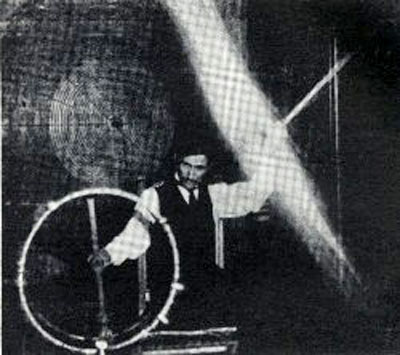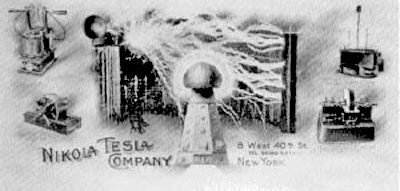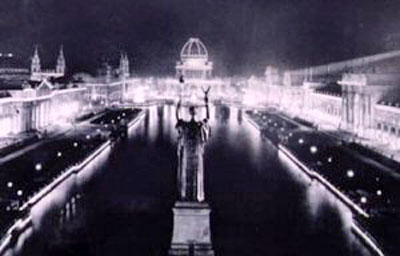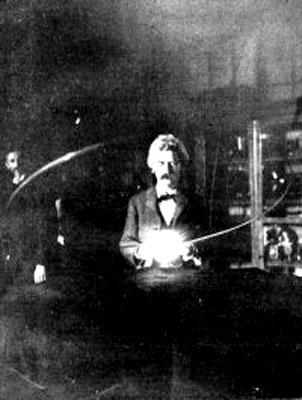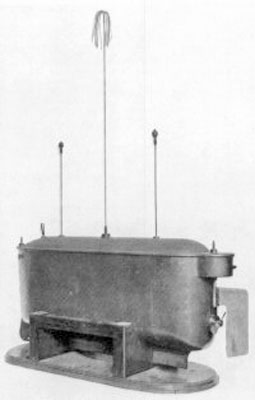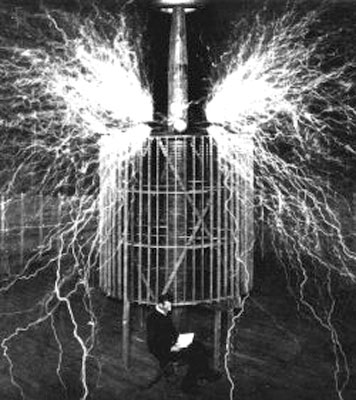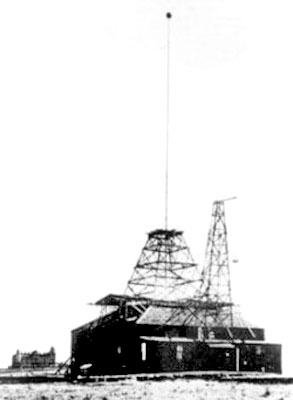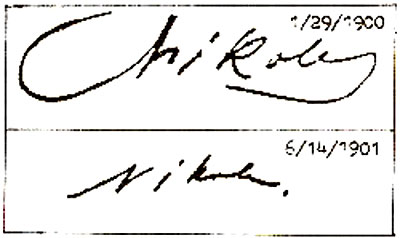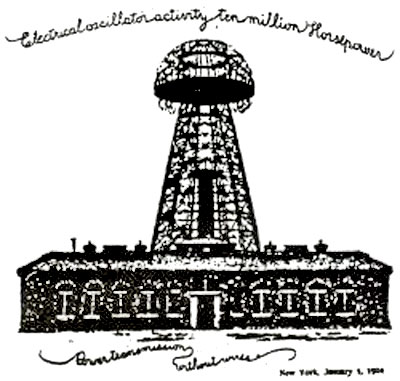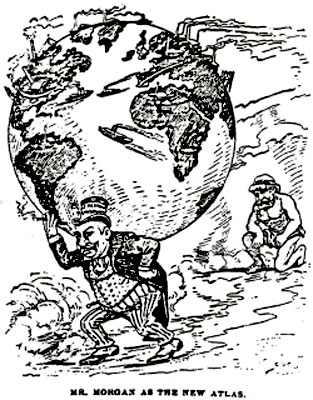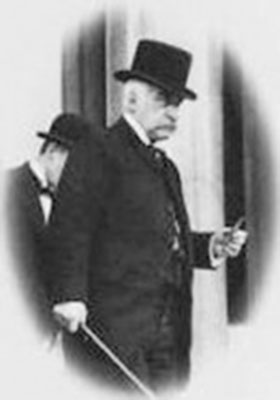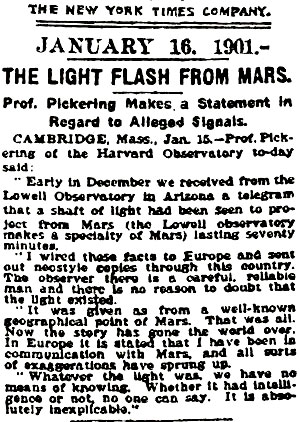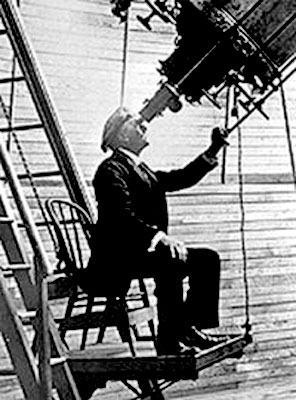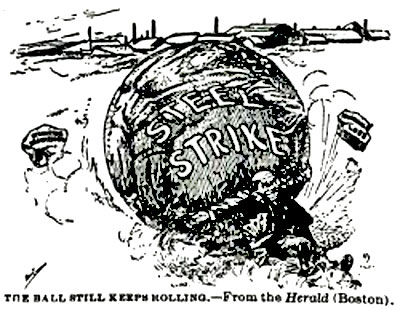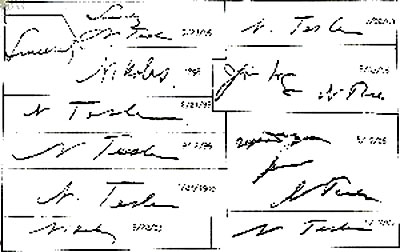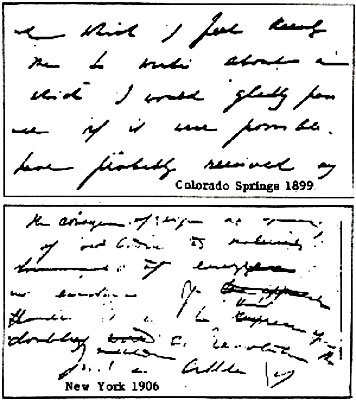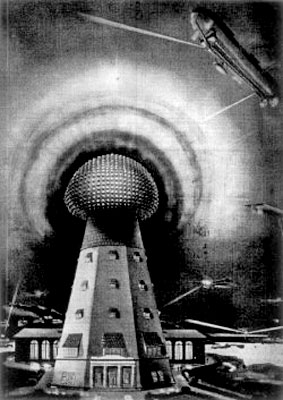|
Volume 4, Issue 1 Jan/Feb/Mar 2006 from TeslaTech Website
Abstract
Tesla died a forgotten man for a number of reasons including psychoanalytic variables in his character, peer jealousy and natural decay over time.
However, two central events in 1901, appear to override other factors.
The first involved Tesla's extraordinary claims of possible contact with extraterrestrial beings, the second, a business arrangement with J. Pierpont Morgan and bitter rivalry with Guglielmo Marconi.
This article will trace Tesla's genius with regards to these events, and also seek to establish with graphological support that Tesla suffered a nervous breakdown in 1906.
Due to his failure with Morgan, as well as society's failure to support a man who had contributed so much, the inventor's plans for a spectacular world-wide wireless system broadcasting light, power and information never materialized.
Figure 1. Nikola Tesla sending 500,000 volts through his body to illuminate a vacuum lamp in a multiple exposure photograph [circa, 1898].
Even during the inventor's lifetime one author admitted that
when Tesla's name was suggested as the greatest living Yugoslavian
American, he "remained embarrassingly silent...The name was not
even vaguely familiar" [8].
William Terbo, Tesla's nephew, head of the Tesla Society, has stated that one major reason for the non-recognition of his uncle's name is that no corporation is closely identified with it.
Although a contributing factor, this
insight does not fully answer the question because no corporation is
closely tied to other comparable inventors that we remember such as
the Wright brothers, Cyrus McCormick or Eli Whitney.
Where 24 students, (55%) of the URI electrical engineering group
knew who Tesla was, not one non-engineering student recognized his
name [37].
Where most treatises on Tesla accept his obscure status as a given, no full-bodied attempt has been made to delineate specific reasons why.
This article attempts to analyze major contributing factors.
The letterhead on Tesla’s stationary highlighted many of his achievements.
Before Tesla's invention, the naturally flowing
alternating current was converted into one direction by means of an
inefficient device called the commutator (a series of wire brushes).
This loss of energy was enormous, and because of it, generators
could only transport electricity about a mile, and then only to
illuminate homes.
A receiving
magnet placed within this field could now turn a motor without the
use of a commutator. He also explained the effect mathematically.
Virtually over night, Tesla's invention created a quantum leap in
the electrical arts.
However, George Westinghouse, an Edison competitor [33] and dabbler in AC devices realized the importance of Tesla's creation and thereupon purchased the invention for a reported million dollars plus royalties.
Westinghouse did not merely acquire a device which did away with a commutator, he obtained the rights to an entire power system which was so complex that it had to be broken down into seven major inventions and 40 patents!
Included in this package were such inventions as:
By 1895 Tesla's invention was successfully utilized in Switzerland, Germany and England, at the Chicago World's Fair and Niagara Falls.
It was also the means for the creation
of the electric railway system. Today, virtually every electrical
power station on the planet owes its existence to Tesla, as his
creation has remained unchanged a full century after its
conceptualization. As a single individual, Tesla altered the course
of history in a dramatic way.
...Tesla died in obscurity.
Ironically, most of his friends and colleagues are still well recognized historical figures.
These notables included,
Tesla was not an obscure hermit inventor; he was a bon-vivant of the Gay Nineties' social elite.
The story of the decline of the fame of Nikola Tesla is a psycho-historical quest [32], [34], [37].
For it would seem that given that he was
the undisputed author of the electrical system utilized today, and
that also his other inventions included wireless communication
(e.g., the radio), neon and fluorescent lamps, remote control, and
the robot, one would think that every child growing up would know
Tesla's name, just as they know Newton's, Galileo's, Edison's, Henry
Ford's or Marconi's.
To explain why this is so, two major events shall be discussed, both culminating in the year 1901: the Tesla/Morgan relationship and the inventor's belief in the possibility of interplanetary communication.
Both are intrinsically
related to the demise of this great inventor.
By this time Morgan had already been financially involved with the "Wizard of Menlo Park" for over four years. In fact, Morgan was the first private citizen in history to have electrical lighting placed in his home. [29]
In 1891 Morgan literally shoved Edison out of his Edison Electric company as the inventor had managed to pile up a 3.5 million dollar debt [16].
By combining the company with the
Thomson-Houston concern, General Electric was born.
In the long run Morgan's engineers such as Steinmetz and Thomson knew that they could not survive with their primitive Edison DC generators. Therefore Morgan approached Westinghouse in the mid 1890's to trade rights of their Vanderpoel trolley patents for the Tesla polyphase system [27].
Due to restrictions on Tesla's contract
with Westinghouse, the inventor received no direct benefit from this
huge financial trade-off.
The first practical telautomaton. A machine having all its bodily or translatory movements and the operations of the interior mechanism controlled from a distance without wires.
Tesla
demonstrated this in 1898 in Madison Square Gardens! At about this same time, in 1898, Tesla invented and displayed his spectacular remote control torpedo boat at the Electrical Show at Madison Square Garden, a magnificent building financed by Morgan and designed and managed by the flamboyant architect Stanford White.
This machine, which Tesla called the tele-automaton, contained all of
the principles of the radio, electrical action at a distance and
also the robot. The press billed the creation as a “torpedo boat
without a crew” [38].
As Morgan was working with McKim of the architectural
firm of McKim, Mead & White, on the construction of the Morgan
Library at the time, and as both Morgan and White were the
principles in the Garden, it is also quite likely that White showed
these photos to Morgan.
During the very months of Tesla's most spectacular experiments including the creation of 100 foot lightning bolts, the young Italian inventor had captured the front page of The New York Times with his wireless coverage of the America's Cup yacht races.
Tesla was well aware of
the coincidence as his secretary/manager George Scherff, who was
minding the New York City laboratory at the time, writes to him on
October 2, 1899 that "The New York Herald continues to boom Marconi"
[42].
As far back as April of 1894, Tesla was described by one author as a dreamer and yet also as,
Tesla appears to be sitting calmly by his 12-million volt coil in Colorado Springs...
actually this is a double exposure (a
technique Tesla used extensively in his research). Certainly, one could say that Tesla himself supported and in truth conceived of this persona as his spectacular lectures and photographs testify.
Tesla was not beyond utilizing trick photography, e.g., multiple exposures, and extraordinary claims in support of his cause. Nevertheless, first and foremost Tesla was a disciplined engineer.
While in Colorado the inventor was able to experimentally establish that he could traverse the globe with electrical pulsations; he also reported that he illuminated light-bulbs by means of wireless transmission at distances of 25 miles from his experimental laboratory.
Tesla's work and ultimate
plans were all published in an extraordinary 25,000 word treatise in
The Century in June of 1900 entitled "The problem of increasing
human energy" [39].
The height of the tower was precisely determined by its harmonic relationship to the size and electrical properties of the earth. The actual tower at Wardenclyffe rose to a height of 187 feet and to a depth of 120 feet, so that total length of the apparatus was 307 feet [1], [6], [9], [19].
Along the main center of the tower was a primary and a secondary coil and condensers which stepped up electrical vibrations to many millions of volts.
Tesla's device
involved the transmission of intense electrical vibrations into the
earth and its reception by similar receiving towers distributed at
any remote point on the globe.
Tesla’s high altitude laboratory in Colorado Springs. Much of Tesla’s controversial work including initial tests
for the
transmission of wireless power was performed here. Liquid air at temperatures of -197° Celcius [44; US Patent 685,012], created by Tesla's mechanical oscillators [44; US Patent 5141,68], would be used to create a "sink hole" [39] to attract transmitted standing waves; and at the same time, the extremely low temperatures would extraordinarily augment the intensity, magnification and duration of captured oscillations.
It's not inconceivable that Tesla
also utilized the principle of superconductivity which would have
dramatically transformed the nature of incoming energies as work in
this area has been traced back to the early 1900's [3].
He gives as an analogy the idea of using electrolysis to change water into hydrogen and oxygen as it flows into a tank (placed at the bottom of a lake). If the system were perfect, the tank would never be filled up and the inflowing water, which could be harnessed, would virtually run forever (or until the supply were exhausted).
Tesla stated explicitly that this ideal situation could not be achieved.
The principle, however, appears sound, resonant
devices and extreme cold (and perhaps superconductivity) would
attract the energy and the magnifying transmitter would convert it
for distribution.
The top signature which Tesla signed shortly after his triumphant return from Colorado Springs reveals flights of fancy and a touch of egomania. The bottom signature appears more serious minded,
written after Tesla becomes aware that Marconi has pirated
his ideas. Not withstanding some doubts, Morgan was impressed, and in the last months of 1900 Tesla was invited to the Morgan home on Madison Avenue where he entertained the family, showing them interesting static electricity and wireless devices, met with his friend Ann, Morgan's daughter, and discussed a potential partnership with the great financier.
Coincidentally, a few months before Tesla finalized
pecuniary arrangements with Morgan, right after his triumphant
return from Colorado, Tesla's handwriting and signature began to
display curious frills to it.
This vision was also discussed with Stanford White, no doubt in 1898 when they worked together at Madison Square Garden in designing a room of artificial illuminescence for the electrical show. For a fee of ~ $950, White donated his time and talents in drafting the blueprints for a mammoth 15 story edifice and an accompanying laboratory.
Both were later erected at Shoreham, Long Island, 65 miles from New York City.
It was
called Wardenclyffe.
The Tesla Magnifying Transmitter and laboratory at Wardenclyffe, Long Island was designed by Stanford White.
This information most likely came directly from Tesla, who O'Neill interviewed extensively for his book.
By the time Hunt and Draper wrote their biography in 1964 [15], they had access to these letters [42] and correctly revealed the details of the Tesla/Morgan partnership (discussed below).
However, neither this second biography or the new Chaney biography
[6] explained exactly why Tesla was unable to complete the tower,
nor the specific reasons why his relationship failed with Morgan.
On December 10, 1900, Tesla writes Morgan to explain why he had withdrawn rather "hastily" the previous Friday evening. Morgan had made a "casual remark" regarding newspaper reports attributing the invention of the wireless and also the AC system to other individuals.
A news-clipping from Professor Slaby, a well respected German electrical engineer, was included which stated that Tesla was,
By 1901, J Pierpont Morgan assumed the title of
“The Most
Powerful Economic Force On The Planet”! The full range of Tesla's credibility was being attacked on all fronts.
For example, in response to Tesla's June 1900 The Century article, Popular Science Monthly wrote a critique entitled "Science and Fiction":
Tesla assures Morgan of his previous priorities in alternating current as well as in wireless and further notes in this same extensive letter that he,
And then as a finale, Tesla boldly challenges the great J.Pierpont Morgan:
The contract was agreed upon in February of 1901 and signed in March.
Tesla was to receive a total of $150,000 ($50,000 more than he had initially asked for), and in return Morgan received 51% of the company and also 51% of all present and future patents in wireless transmission and artificial daylight. This was not to Tesla's liking as he had proposed Morgan only take a percentage of the company, not the patents.
Tesla "said nothing for fear of
offending you". [41; 10/13/1404].
J.P. Morgan’s signature on the 1901 contract with Nikola Tesla
regarding the development of wireless communication. As designer for the changing evolution of human life, Tesla took liberties in his perception of his business dealings with Morgan. However, from the financier's point of view, the arrangement was quite straightforward.
This was in no way a philanthropic
investment.
The very months Tesla worked out the details of his partnership, Morgan was also organizing a huge steel trust which would be capitalized at one and one-half billion dollars. By March of 1901 Morgan controlled the steel, electrical, shipping, mining and power industries; he also had a large paw in the telephone, railroad and insurance conglomerates.
The new potentials in wireless was a small side bet
for Pierpont.
However, the financier was to have his troubles
with the steel monopoly, partly because of market problems and
mostly because of labor disputes.
The sham worked and within a few weeks the Big Board experienced the most active trading days in the history of the stock exchange. A month later Morgan sailed on his yearly sojourn to Europe. He hoped, by the time of his return that his steel company would be stabilized and his wireless operations would be transmitting transatlantic messages.
Times looked good.
This front page article of the New York Times was yet another 'scientific' confirmation of life on Mars.
Much of it had to do with his spectacular interplanetary statements.
Influenced by the Harvard
astronomer Perceival Lowell, who discussed his analysis of the
'canals of Mars' and his belief of intelligent life there, and by
science fiction writings about Martians by H.G. Wells and George DuMaurier (Daphne's grandfather)
[35], Tesla announced to the world
that he may have received pulsed frequencies from outer-space, most
likely Venus or Mars.
Numerous critics attacked Tesla's credibility.
I think it is fair to say in terms of fame and acceptance, Tesla has never recovered, even today, 60 years after his death and over 100 years after the articles began. His name fell from grace, lost for years in occult circles and on dusty book shelves [31], [35], [36].
A mysterious Mr. X from one periodical:
Percival Lowell (1855-1916) is shown here at his world renowned observatory near Flagstaff.
His writings on Mars
fueled much speculation in scientific circles at the turn of the
20th Century! The attack, however, was not monolithic.
The Electrical World & Engineer, a much
more prestigious and honorable magazine simply reported Tesla's
interplanetary claims. Having reported Lowell's 'canals of Mars'
discoveries as well (for the past 7 years), the electrical community
was not as horror struck as factions of the popular press.
The die was cast after Tesla read an article by Marconi on his new wireless patents which were endorsed by consulting engineers Pupin and Edison:
Tesla refers to the event in a letter to Morgan which was written three years later:
In this passage Tesla displays a complete misunderstanding of Morgan's personality, because, unlike the inventor whose ideas existed in abstract and futuristic places, Morgan's mind was on the present.
He loved sailing and yacht races, and
would resent another suggesting what a man in his position should do
or not do.
Paradoxically for the altruistic Tesla,
his greed was also a strong motivational force as his goal was
simply to bury the opposition and create a business "commensurate
with your [Morgan's] position in life and mine as a pioneer in this
art, who has originated all essential principles [42; 10/13/1904].
This world-wide wireless system would distribute not only simple Morse coded messages, which was all Marconi had ever planned, but also international telephone conversations, pictures and newspaper articles to sailing vessels, power to run London trams, and light for the world.
Tesla's ultimate vision even included
the creation of rain in the deserts, artificial daylight in the
skies to illuminate shipping lanes at night, and also interplanetary
communication!
To the inventor, it was a detail that this vision was not in agreement with the specifics of the contract, (or that if he had succeeded, hiorgan and the rest of the financial community would have had to revolutionize their power, lighting and communication systems).
And even if, by some fluke of misfortune
Morgan should not supply additional funds, Tesla still had his own
money and the personality to attract additional investors.
Figure 15. A steelworkers’ strike severely threatens Morgan’s billion dollar trust.
Tesla referred back to these events occurring in the Spring of 1901, two years later in yet another letter to Morgan:
This note refers to May of 1901, specifically to May 10th, when the stock market crashed; and to the days leading up to the 10th.
It was just 60 days since Tesla had signed his contract with Morgan, 30 days after Morgan sailed for Europe; yet already Tesla had irreversibly changed his plans. Having been a gambler and pool player in college and in his early days in New York City, these old tendencies resurfaced after Tesla hooked on to the biggest fish on Wall Street.
He had calculated the odds based upon
certain assumptions about the stability of the economy and the
quickness of his access to Morgan's $150,000, and he proceeded
boldly and confidently with the completion of the masterpiece.
Before leaving for Europe, Morgan had
secured control of a third competing line, the Chicago Burlington,
which stretched its tracks from the East coast to Chicago and down
the Mississippi to New Orleans.
It would take close to $100 million in the sale of new bonds to raise the capital, but by the time Morgan found out while with his mistress in France, Harriman already had more than 50% of the 'Nipper', but less than 50% of the common stock voting shares. Morgan cabled to his Wall Street office to buy his company back at any price.
On May 9th, the stock rose from 150 to
1000 dollars per share!!
In response, Morgan was quoted as saying
that it would be quite a feat to "unscramble the eggs and return
them to their original hens!"
These series of signatures display the versatility of Tesla's self image over a 10 year period. Note the extremely small capital N in the 8/21/1899 sample created at the height of his creative ability while in Colorado. At times, Tesla had a rather small self image. Inner contradiction is revealed by the vast size changes in the first initial.
Note how the
structure of the handwriting disintegrates in 1906. Tesla, as one of any number of innocent casualties, was now in a difficult situation.
The economy had collapsed out from underneath him ironically due to the very man he required more capital from. This was not a good time for Tesla to meet with Morgan, to explain his change of plans, request the balance of the initial $150,000 and ask for additional funds.
Headlines such as the following rattled
the soul of the family minded mighty financier:
Throughout July of 1901 Morgan lived aboard his 300 foot long yacht the Corsair, which was docked at a pier near his Wall Street office [30].
During this month Tesla met with him to explain to Morgan that he had changed their agreement in order to build a more powerful transmitter. He softens the blow by stating that the larger plan will not only destroy competition, but also it will yield larger profits.
Morgan, however, remains unmoved and demands a clearer accounting of where all the money already assigned has gone.
Tesla, having already blundered, makes things worse by stating that:
Morgan is appalled.
Tesla had not only reminded Morgan that he is responsible for the upheaval on Wall Street, but also, Tesla had, in effect, breached his contract. In September, Morgan's ally, President McKinley was shot by an anarchist. During the week that he lay dying, and at a time Morgan stated was the most unhappy moment in his life [30].
Tesla wrote another plea for additional capital.
His timing is atrocious; however, Morgan still owed Tesla money on the original agreement and Tesla was facing foreclosure even before construction on the tower had begun [42; letter to White, 9/13/1901].
In November, Tesla regroups and sends Morgan legal documents including patents on various crucial aspects of his wireless machinery.
He promises once again to beat Marconi in the race for the wireless. Morgan acknowledges receipt of the patents in a letter from his secretary to Tesla on November 11, 1901.
However, in December, Marconi successfully transmits the letter S (dot/dot/dot - the same 3 impulses Tesla said he received from outerspace while he was in Colorado in 1899 [37] ) from England to Canada.
The coffin was shut on Tesla's
relationship with Morgan, and Marconi gained the crown as the
world's greatest inventor in wireless.
The top sample, typical of Tesla's script through the years displays clarity and inner strength. The bottom sample shows a disintegration of the writing trail... indicating a mental collapse.
With courage, foresight for the transcendent picture, perseverance and also a sense of destiny behind him, Tesla continued his project for another 9 months, proceeding publically as if all were well. The tower was raised to its full 187 feet, with elaborate bulbous top some time in the latter half of 1902.
Surely when Mr. Morgan saw; surely when Mr. Morgan comprehended, and understood how far the inventor had come with such inadequate funds, the noble philanthropist and church going nobleman would relent, change his mind and help once again his protégé of the electrical arts; for Morgan was Tesla's protégé as well.
Driven by ego-mania, a neurotic dependency and irreconcilable need to change Morgan's opinion, the inventor was unrelentless in his pleas and sends another barrage of letters:
Ready to give the world the greatest invention of all times, Tesla is on the verge of collapse.
He even tells Morgan as much at the end of a 1500 word letter reproduced in part throughout this text:
Tesla tries everything to make Morgan
transcend the petty material plane from which their business
arrangement had been fashioned. As he writes, his $200,000
magnifying transmitter and laboratory stand as a giant, yet impotent
shadow of awesome potentiality.
Tesla had purposely written to Morgan when the financier was meeting with the Archbishop of Canterbury [30], trying to appeal to his Christian spirit.
It is a last stance, a final try to tap
into Morgan's higher centers, but the great inventor is about to
crumble:
Tesla had pulled out all stops. One can not help but be moved by reading through these letters.
Naturally Tesla was negotiating with other potential investors including,
...three of the richest men in the world.
However,
due to an insurance scandal involving these individuals, as well as
various stumbling blocks Morgan placed on the situation (such as
requiring reimbursement of his initial investment), Tesla was unable
to gain another backer.
Due to my work in graphology, I have discovered a complete disintegration in his handwriting in that year [32].
His secretary George Scherff confirms my hypothesis:
This photograph of a model shows how the Tesla Tower built on Long Island in 1901 would have looked completed. From its appearance nobody would infer that it was to be used for great purposes which far exceeded “wireless” communications.
A genius whose inventions of the polyphase system, fluorescent lights, the induction motor, the radio, remote control and artificial intelligence is unparalleled in the annals of creative achievement.
One could look to his ego-mania
and unrelentless tunnel vision regarding the psychoanalytic need to
turn Morgan back his way for his ultimate failure at Wardenclyffe,
or to Morgan's insensitivity. However, it took incredible wit,
courage and strategic planning not only to land a deal with Morgan
in the first place, but to erect the laboratory and 187 foot tower
after his falling out with the Wall Street tycoon.
Having
given humanity inventions that are still the backbone of our
technological existence, Tesla was incapable of comprehending that a
man as powerful as Morgan lacked the ability to transcend the limits
of their written agreement. Morgan, as a man of principle, saw a
breach of contract, and that was that.
Nevertheless, Tesla was by no means alone in his belief of intelligent life beyond the Earth.
Other proponents included,
Even as late as 1956 Werner von Braun
voiced the likelihood that Mars was inhabited by vast stretches of
vegetation [46].
Nevertheless, the phenomena
involved with the eventual placement of his achievement under-
ground and the virtual removal of his name from many history books
has only been partly explained. Other variables include: vindictive
jealousy among his peers, the removal of his name from the
Westinghouse motor, the trauma of the intervening world wars and
natural decay over time.
Tesla had placed his trust in society - he had proven himself in the past in an extraordinary way - and society had failed him. Fear of transcendent potentialities, denial of previously cherished beliefs (such as life on Mars) and a strong need to simplify the nature of existence were also factors.
Marconi,
with his wireless beep machine was a lot easier to comprehend.
|

